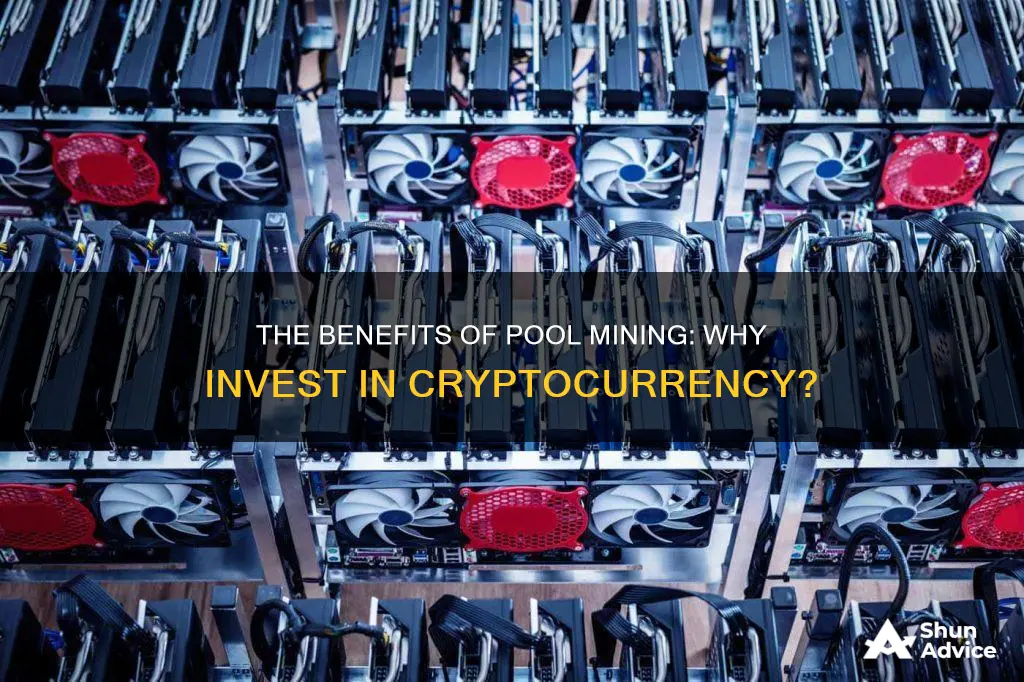
Cryptocurrency mining has become increasingly competitive, with large mining operations dominating the market. As a result, small-scale miners have been forced to join mining pools to increase their chances of earning rewards. Mining pools are groups of cryptocurrency miners who combine their resources and computational power to solve the complex mathematical problems required to mine new blocks on a blockchain. By working together, miners in a pool can increase their processing power and become more competitive with large mining operations.
Mining pools offer several benefits to participants, including increased chances of earning rewards, reduced hardware and electricity costs, and the ability to compete with major players in the mining industry. However, there are also some disadvantages to joining a mining pool, such as reduced autonomy in the mining process and the need to share any potential rewards.
| Characteristics | Values |
|---|---|
| Purpose | To increase the chances of receiving a reward for mining cryptocurrency |
| Participants | Cryptocurrency miners |
| Function | Participants combine their computational resources to increase the chances of successfully mining for cryptocurrency |
| Rewards | If the mining pool is successful, the reward is divided among participants based on their contribution |
| Payout Schemes | Pay-per-share (PPS), pay-per-last-N-shares (PPLNS), full-pay-per-share (FPPS), shared maximum pay per share (SMPPS), pay-per-share plus (PPS+), etc. |
| Advantages | More affordable, higher chances of receiving a reward, less hardware and electricity costs |
| Disadvantages | Loss of autonomy, lower share of earnings, potential centralization and control issues |
What You'll Learn
- Pool mining increases your chances of being rewarded for your work
- Pool mining is the only way to earn Bitcoin due to the centralization of the network's mining capacity
- Pool mining is more affordable than solo mining
- Pool mining allows you to compete with large organisations
- Pool mining distributes rewards in various ways

Pool mining increases your chances of being rewarded for your work
Pool mining is a collaborative effort where cryptocurrency miners combine their computational resources and processing power to increase their chances of earning rewards. By joining a mining pool, individuals can boost their odds of successfully mining for cryptocurrency and receiving a portion of the block reward.
In the context of cryptocurrency mining, a mining pool allows miners to share their processing power over a network. The reward is then split among the pool members according to the amount of work they contributed or the probability of finding a block. This collaborative approach is particularly advantageous when mining for cryptocurrencies like Bitcoin, which has become very difficult for individual miners to mine due to the high computational power and resource requirements.
Mining pools give miners the opportunity to bring their computing power together to obtain steady rewards. By working together, miners increase their collective hashing power, which improves their chances of solving the complex cryptographic problems required by certain blockchains. This is especially beneficial for miners with low computing power, as it allows them to team up with other miners and find several blocks per day.
The rewards earned by the mining pool are typically distributed using payout schemes such as Pay-per-Share (PPS), Pay-per-Last-N-Shares (PPLNS), or Full-Pay-Per-Share (FPPS). These schemes take into account the proportion of processing power or work contributed by each individual miner. By joining a mining pool, participants can increase their odds of receiving cryptocurrency rewards, making it a more attractive option for those looking to supplement their income or make investments in the cryptocurrency space.
Robert Kiyosaki's Bitcoin Investment Strategy
You may want to see also

Pool mining is the only way to earn Bitcoin due to the centralization of the network's mining capacity
Mining pools are groups of cryptocurrency miners who connect their machines over a network to increase their chances of earning rewards for opening new blocks. New blocks are opened when a miner solves a cryptographic problem, which requires high processing power and electricity consumption. The process is time-consuming and energy-intensive, and it can take years to become profitable after purchasing and maintaining the necessary equipment. As a result, joining a mining pool is the most affordable way to increase the odds of receiving cryptocurrency rewards.
Mining pools combine the computational resources of individual miners or smaller mining groups, making them more competitive with the large mining operations that dominate the network. The rewards earned through pool mining are split among the pool members based on their contributions. While individual mining grants complete ownership of the reward, the odds of success are very low due to the high computational power and resource requirements.
The centralization of mining capacity in a few large pools, such as AntPool, Foundry, ViaBTC, F2Pool, and Binance Pool, goes against the intended decentralized structure of Bitcoin. However, it has become necessary for users to participate in these pools to receive rewards and contribute to the blockchain's functioning.
To summarize, pool mining is the only viable way to earn Bitcoin due to the centralized nature of the network's mining capacity, which has led to the formation of large mining pools that individual miners cannot compete with. By joining a mining pool, participants can increase their chances of receiving rewards and contribute to the blockchain ecosystem.
Metal Coins: Worthy Investment or Risky Business?
You may want to see also

Pool mining is more affordable than solo mining
Another advantage of pool mining is that it provides access to advanced hardware and state-of-the-art mining equipment. This is especially beneficial for small-scale or individual miners who may not have the financial resources to invest in expensive mining rigs on their own. Pool mining also offers a more stable and predictable income stream compared to solo mining. Rewards are distributed based on each miner's contribution to the pool's total hash rate, ensuring that participants receive consistent returns for their work.
In addition, pool mining is generally more accessible to newcomers or those with low hash rates. It requires less technical knowledge and expertise compared to solo mining, making it a more inclusive option for those interested in cryptocurrency mining. Pool mining also reduces the risks associated with solo mining, such as equipment failure or fluctuations in network difficulty.
While solo mining offers the advantage of complete control and autonomy, it also comes with higher investment costs and a greater level of uncertainty. Solo miners need to have powerful hardware and bear the risk of experiencing long periods without successfully mining a block, resulting in irregular or infrequent rewards. Therefore, pool mining is a more affordable and accessible option for many individuals interested in cryptocurrency mining.
Yuan Crypto Investment: A Beginner's Guide to Getting Started
You may want to see also

Pool mining allows you to compete with large organisations
Pool mining is a collaborative effort that allows individual miners with limited resources to join forces and compete with large organisations. By pooling their resources, smaller miners can increase their computational power and enhance their chances of successfully mining for cryptocurrency.
In the competitive world of cryptocurrency mining, individual miners often struggle to keep up with large mining operations that have extensive resources. Pool mining offers a solution by allowing these smaller miners to combine their mining machines and form a network. This collective approach boosts their chances of earning rewards for opening new blocks on the blockchain.
The process of mining new blocks is complex and resource-intensive. It requires significant computational power and energy, which can be costly for solo miners. By joining a mining pool, participants can share the burden of these expenses. The pooling of resources increases the group's likelihood of success, and when one individual in the mining pool successfully mines a block, the group splits the reward. This shared effort makes it more feasible for smaller miners to compete with large organisations.
Additionally, pool mining provides an opportunity for miners to collaborate and share knowledge. The collective intelligence and expertise of the group can be a valuable asset, enabling participants to stay updated with the latest mining techniques and strategies. This knowledge sharing can further enhance their competitiveness against large organisations with dedicated resources.
It's important to note that while pool mining offers advantages, it also comes with trade-offs. Miners give up some autonomy by agreeing to the terms set by the pool. They also need to divide any rewards, resulting in a lower share of earnings for individuals. Nevertheless, for those with limited resources, pool mining presents a viable option to compete in the cryptocurrency mining arena, dominated by large organisations with extensive resources.
Trump Coins: Worthy Investment or Risky Business?
You may want to see also

Pool mining distributes rewards in various ways
Pool mining is a popular way for individuals to mine cryptocurrency, especially Bitcoin. Pool mining is a collaborative effort where miners combine their computational resources to increase their chances of receiving a reward. The reward earned is then distributed among the pool members. There are several ways in which pool mining rewards are distributed.
One of the most common methods is the Pay-Per-Share (PPS) system, where miners are paid a fixed amount for each share they submit, regardless of whether the pool finds a block. This method offers stable payouts but often comes with higher fees. Another common method is the Proportional (PROP) system, where miners earn shares until a block is found, and then they receive a reward proportional to their share of the total work done.
Another method is Pay-Per-Last-N-Shares (PPLNS), which calculates payouts based on the last N shares contributed by a miner, not just the shares in the current round. This method rewards loyalty and discourages pool hopping. A similar method is the Equalized Shared Maximum Pay Per Share (ESMPPS), which distributes payments equally among all miners in the pool.
Other less common methods include the Double Geometric Method (DGM), Recent Shared Maximum Pay Per Share (RSMPPS), Capped Pay Per Share with Recent Backpay (CPPSRB), and Bitcoin Pooled Mining (BPM). Each of these methods has its own advantages and disadvantages in terms of payout stability, fees, and the variability of earnings.
When choosing a mining pool, it is important to consider the pool's size, stability, fees, transparency, and payout scheme. By joining a mining pool, individuals can increase their chances of receiving rewards and reduce their overall costs.
Tom Brady's Bitcoin Bet: Millions Invested
You may want to see also
Frequently asked questions
A mining pool is a group of cryptocurrency miners who combine their resources to increase their chances of receiving a reward for opening a new block.
Joining a mining pool increases an individual's chances of receiving a reward for their mining efforts. It also allows them to compete with larger mining organisations without having to invest in expensive mining equipment.
Mining pools combine the computational resources of individual or smaller mining groups to make them more competitive with large mining operations. Pool participants contribute their processing power toward finding a new block. If the pool is successful, they receive a reward, typically in the form of cryptocurrency, which is then divided among the participants.
Rewards are usually divided among the miners based on the pool's payout scheme. Some common payout schemes include pay per share (PPS), pay per last N shares (PPLNS), and pay per share plus (PPS+). Each scheme calculates payouts based on the share of work contributed by each miner.
Joining a mining pool has some risks, including centralization and security concerns, trust issues with pool operators, and the potential for pool hopping by miners seeking better rewards. Additionally, there may be recurring fees associated with pool participation, and any rewards received will need to be shared with other pool members.







